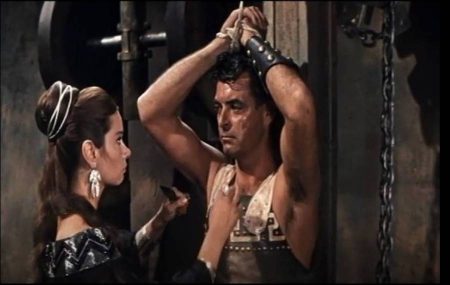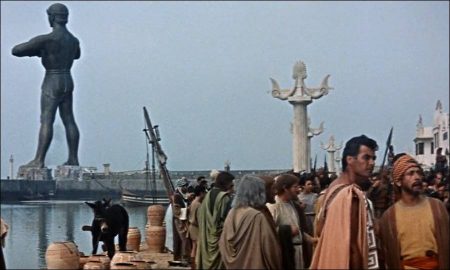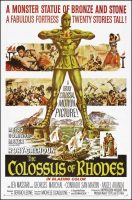The Colossus of Rhodes movie storyline. A Greek military hero named Darios visits his uncle in Rhodes in the year 280 BC. Rhodes has just finished constructing an enormous colossus of Apollo to guard its harbor and is planning an alliance with Phoenicia which would be hostile to Greece. Darios flirts with the beautiful Diala, daughter of the statue’s mastermind, while becoming involved with a group of rebels headed by Peliocles.
These rebels seek to overthrow the tyrannical King Serse as does Serse’s evil second-in-command, Thar. The rebels’ revolt seems to fail, with Peliocles and his men being captured and forced to provide amusement in the local arena, but an earthquake eventually upsets, not only the Colossus in the harbor, but the balance of power in Rhodes as well.
The Colossus of Rhodes (Italian: Il Colosso di Rodi) is a 1961 Italian sword and sandal film co-written and directed by Sergio Leone. Starring Rory Calhoun, it is a fictional account of the island of Rhodes during its Classical period in the late third century before coming under Roman control, using the Colossus of Rhodes as a backdrop for the story of a war hero who becomes involved in two different plots to overthrow a tyrannical king: one by Rhodian patriots and the other by Phoenician agents.
The film was Leone’s first work as a credited director, in a genre where he already had worked before (as the replacement director for The Last Days of Pompeii and as a secondary director for both Ben-Hur and Quo Vadis). It is perhaps the least known of the seven films he officially directed, and is notable for being the only one without an Ennio Morricone score.
The film is also notable for its unusual time period: The time following Alexander the Great’s death (323 BC) but before the rise of the Roman empire (27 BC), known as the Hellenistic era. Most sword-and-sandal epics of the 1950s and 1960s were set in either classical Greece or even earlier (Hercules, Ulysses, The Giant of Marathon) or the later Roman period (Ben Hur, The Magnificent Gladiator, Quo Vadis). The only other films made during the peplum era to use a Hellenistic setting are Hannibal (1959), Revak the Rebel and Siege of Syracuse (both 1960).
The film was originally meant to star John Derek. However he clashed with Sergio Leone and was replaced by Rory Calhoun. Leone filmed exterior scenes at the Laredo harbour, Cantabria, the Bay of Biscay, the Manzanares el Real and Ciudad Encantada at Cuenca.
Depiction of the Colossus
Although no physical references of the original Helios Colossus are known to exist, the structure is rendered in this film as being an Etruscan image of the god Apollo following the kouros style of sculpture, with a slight “archaic smile.” It is shown to be about 300 feet high (nearly three times the height of its historical counterpart) holding a bowl at chest level with elbows raised outward, straddling each side of the harbor entrance.
It is also revealed to be a hollow metal sculpture, much on the same order as the Statue of Liberty, with several interesting features: an interior spiral staircase leading to a second set of stairs at the head of the statue; a chain system that runs practically the height of the statue, which controls sliding doors to a dungeon; permanent openings at the pupils of the eyes and the ears – large enough for a man to pass through; a drawbridge-style door hidden in the center chest that opens to the bowl; the bowl can be filled with burning materials and used as an altar; the fire in the bowl can be dropped on anything beneath by means of a divided trap door on its bottom; and the entire top third of the statue’s head has a dodecagonal opening that allows for catapults to be fired out of it.
While the statue in the film is shown to be made of iron and burnished brass (or perhaps bronze) and barefoot, barechested and bareheaded, wearing only a short men’s Greek-style skirt and a headband, the original poster depicts the statue as highly polished bronze, completely outfitted with Roman sandals and armor, including a centurion’s imperial galea.
The Colossus of Rhodes (1961)
Directed by: Sergio Leone
Starring: Rory Calhoun, Lea Massari, Georges Marchal, Conrado San Martín, Ángel Aranda, Mabel Karr, Mimmo Palmara, Roberto Camardiel, Alfio Caltabiano, George Rigaud, Carlo Tamberlani
Screenplay by: Ennio De Concini, Sergio Leone, Cesare Seccia, Luciano Martino, Ageo Savioli, Luciano Chitarrini, Carlo Gualtieri
Production Design by: Ramiro Gómez
Cinematography by: Antonio L. Ballesteros
Film Editing by: Eraldo Da Roma
Costume Design by: Vittorio Rossi
Makeup Department: Angelo Malandrucco, Carlos Nin
Music by: Angelo Francesco Lavagnino
MPAA Rating: None.
Distributed by: Filmar (Italy), Metro-Goldwyn-Mayer (International)
Release Date: June 16, 1961
Visits: 135


